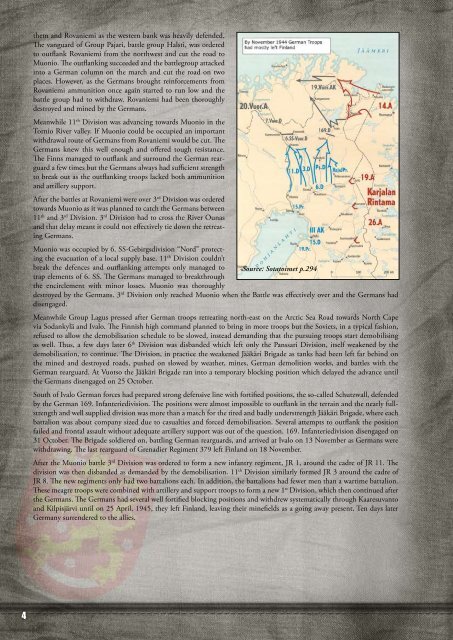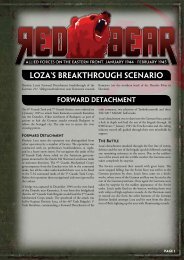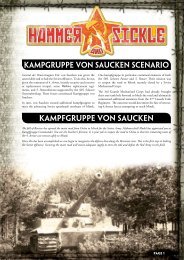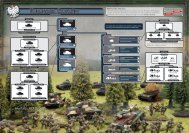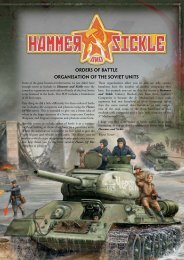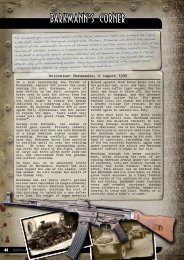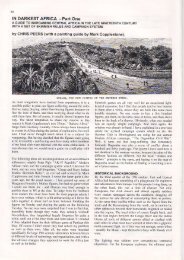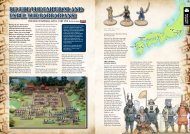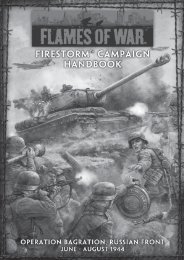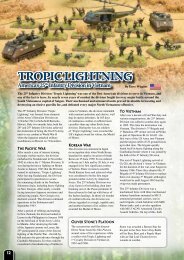Finns in Lapin Sota (PDF)... - Flames of War
Finns in Lapin Sota (PDF)... - Flames of War
Finns in Lapin Sota (PDF)... - Flames of War
You also want an ePaper? Increase the reach of your titles
YUMPU automatically turns print PDFs into web optimized ePapers that Google loves.
them and Rovaniemi as the western bank was heavily defended.<br />
The vanguard <strong>of</strong> Group Pajari, battle group Halsti, was ordered<br />
to outflank Rovaniemi from the northwest and cut the road to<br />
Muonio. The outflank<strong>in</strong>g succeeded and the battlegroup attacked<br />
<strong>in</strong>to a German column on the march and cut the road on two<br />
places. However, as the Germans brought re<strong>in</strong>forcements from<br />
Rovaniemi ammunition once aga<strong>in</strong> started to run low and the<br />
battle group had to withdraw. Rovaniemi had been thoroughly<br />
destroyed and m<strong>in</strong>ed by the Germans.<br />
Meanwhile 11 th Division was advanc<strong>in</strong>g towards Muonio <strong>in</strong> the<br />
Tornio River valley. If Muonio could be occupied an important<br />
withdrawal route <strong>of</strong> Germans from Rovaniemi would be cut. The<br />
Germans knew this well enough and <strong>of</strong>fered tough resistance.<br />
The <strong>F<strong>in</strong>ns</strong> managed to outflank and surround the German rearguard<br />
a few times but the Germans always had sufficient strength<br />
to break out as the outflank<strong>in</strong>g troops lacked both ammunition<br />
and artillery support.<br />
After the battles at Rovaniemi were over 3 rd Division was ordered<br />
towards Muonio as it was planned to catch the Germans between<br />
11 th and 3 rd Division. 3 rd Division had to cross the River Ounas<br />
and that delay meant it could not effectively tie down the retreat<strong>in</strong>g<br />
Germans.<br />
Muonio was occupied by 6. SS-Gebirgsdivision “Nord” protect<strong>in</strong>g<br />
the evacuation <strong>of</strong> a local supply base. 11 th Division couldn’t<br />
break the defences and outflank<strong>in</strong>g attempts only managed to Source: <strong>Sota</strong>toimet p.294<br />
trap elements <strong>of</strong> 6. SS. The Germans managed to breakthrough<br />
the encirclement with m<strong>in</strong>or losses. Muonio was thoroughly<br />
destroyed by the Germans. 3 rd Division only reached Muonio when the Battle was effectively over and the Germans had<br />
disengaged.<br />
Meanwhile Group Lagus pressed after German troops retreat<strong>in</strong>g north-east on the Arctic Sea Road towards North Cape<br />
via Sodankylä and Ivalo. The F<strong>in</strong>nish high command planned to br<strong>in</strong>g <strong>in</strong> more troops but the Soviets, <strong>in</strong> a typical fashion,<br />
refused to allow the demobilisation schedule to be slowed, <strong>in</strong>stead demand<strong>in</strong>g that the pursu<strong>in</strong>g troops start demobilis<strong>in</strong>g<br />
as well. Thus, a few days later 6 th Division was disbanded which left only the Panssari Division, itself weakened by the<br />
demobilisation, to cont<strong>in</strong>ue. The Division, <strong>in</strong> practice the weakened Jääkäri Brigade as tanks had been left far beh<strong>in</strong>d on<br />
the m<strong>in</strong>ed and destroyed roads, pushed on slowed by weather, m<strong>in</strong>es, German demolition works, and battles with the<br />
German rearguard. At Vuotso the Jääkäri Brigade ran <strong>in</strong>to a temporary block<strong>in</strong>g position which delayed the advance until<br />
the Germans disengaged on 25 October.<br />
South <strong>of</strong> Ivalo German forces had prepared strong defensive l<strong>in</strong>e with fortified positions, the so-called Schutzwall, defended<br />
by the German 169. Infanteriedivision. The positions were almost impossible to outflank <strong>in</strong> the terra<strong>in</strong> and the nearly fullstrength<br />
and well supplied division was more than a match for the tired and badly understrength Jääkäri Brigade, where each<br />
battalion was about company sized due to casualties and forced demobilisation. Several attempts to outflank the position<br />
failed and frontal assault without adequate artillery support was out <strong>of</strong> the question. 169. Infanteriedivision disengaged on<br />
31 October. The Brigade soldiered on, battl<strong>in</strong>g German rearguards, and arrived at Ivalo on 13 November as Germans were<br />
withdraw<strong>in</strong>g. The last rearguard <strong>of</strong> Grenadier Regiment 379 left F<strong>in</strong>land on 18 November.<br />
After the Muonio battle 3 rd Division was ordered to form a new <strong>in</strong>fantry regiment, JR 1, around the cadre <strong>of</strong> JR 11. The<br />
division was then disbanded as demanded by the demobilisation. 11 th Division similarly formed JR 3 around the cadre <strong>of</strong><br />
JR 8. The new regiments only had two battalions each. In addition, the battalions had fewer men than a wartime battalion.<br />
These meagre troops were comb<strong>in</strong>ed with artillery and support troops to form a new 1 st Division, which then cont<strong>in</strong>ued after<br />
the Germans. The Germans had several well fortified block<strong>in</strong>g positions and withdrew systematically through Kaaresuvanto<br />
and Kilpisjärvi until on 25 April, 1945, they left F<strong>in</strong>land, leav<strong>in</strong>g their m<strong>in</strong>efields as a go<strong>in</strong>g away present. Ten days later<br />
Germany surrendered to the allies.


